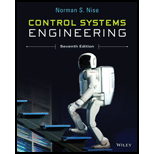
The different applications of a feedback control system.
Explanation of Solution
Feedback plays an important in control system. Feedback is defined as some part of the output or the value of the output returned to the input side which can be utilized as a part of input to obtain the desired output and system containing feedback are known as feedback control system. In these systems, input value is supplied and the output of the feedback system is being compared continuously with the desired reference value in order to evaluate exact deviations of the output value from the reference value. Feedback control systems helps in modifying the system dynamic response with no change in system components. The three different applications of a feedback control system are:
- Robot vehicle or a manipulator arm.
- Space Craft
- Elevator
Want to see more full solutions like this?
Chapter 1 Solutions
Control Systems Engineering
- 3 Answer: 002 PROBLEM 15.188 The rotor of an electric motor rotates at the constant rate @₁ = 1800 rpm. Determine the angular acceleration of the rotor as the motor is rotated about the y axis with a constant angular velocity 2 x of 6 rpm counterclockwise when viewed from the positive y axis. α = (118.4 rad/s²)iarrow_forward12 in.. 10 in. PROBLEM 15.187 At the instant considered the radar antenna shown rotates about the origin of coordinates with an angular velocity @ = ai + @j+wk Knowing that (VA) = 15 in./s, (VB), 9 in./s, and (VB), = 18 in./s, determine (a) the angular velocity of the antenna, (b) the velocity of point A. B 10 in. Answers: = (0.600 rad/s)i - (2.00 rad/s) j + (0.750 rad/s)k V₁ = (20.0 in./s)i + (15.00 in./s) j + (24.0 in./s)karrow_forward3. An engine has three cylinders spaced at 120° to each other. The crank torque diagram can be simplified to a triangle having the following values: Angle 0° Torque (Nm) 0 (a) What is the mean torque? 60° 4500 180° 180° to 360° 0 0 (b) What moment of inertia of flywheel is required to keep the speed to within 180 ± 3 rpm? (c) If one cylinder of the engine is made inoperative and it is assumed that the torque for this cylinder is zero for all crank angles, determine the fluctuation in speed at 180rpm for the same flywheel. (a) 3375 Nm (b) 50kgm (c) ±21 rpmarrow_forward
- Prob 5. Determine the largest load P that can be applied to the frame without causing either the average normal stress or the average shear stress at section a-a to exceed o-150 MPa and 1-60 MPa, respectively. Member CB has a square cross section of 25 mm on each side. 2 m FAC 1.5 m Facarrow_forwardDerive the component transformation equations for tensors shown below where [C] = [BA] is the DCM (direction cosine matrix) from frame A to B. ^B [T] = [C]^A [T] [C]^Tarrow_forwardCalculate for the vertical cross section moment of inertia for both Orientations 1 and 2 of a 1 x 1.5 in. horizontal hollow rectangular beam with wall thickness of t = 0.0625 in. Use the equation: I = ((bh^3)/12) - (((b-2t)(h-2t)^3)/12)arrow_forward
- Please answer 'yes' or 'no' and 'is' or 'is not' for the following:arrow_forwardConsider a large 23-cm-thick stainless steel plate (k = 15.1 W/m-K) in which heat is generated uniformly at a rate of 5 x 105 W/m³. Both sides of the plate are exposed to an environment at 30°C with a heat transfer coefficient of 60 W/m²K. The highest temperature will occur at surfaces of plate while the lowest temperature will occur at the midplane. Yes or No Yes Noarrow_forwardMy answers are incorrectarrow_forward
- Picturearrow_forwardWhat is the weight of a 5-kg substance in N, kN, kg·m/s², kgf, Ibm-ft/s², and lbf? The weight of a 5-kg substance in N is 49.05 N. The weight of a 5-kg substance in kN is KN. The weight of a 5-kg substance in kg·m/s² is 49.05 kg-m/s². The weight of a 5-kg substance in kgf is 5.0 kgf. The weight of a 5-kg substance in Ibm-ft/s² is 11.02 lbm-ft/s². The weight of a 5-kg substance in lbf is 11.023 lbf.arrow_forwardMych CD 36280 kg. 0.36 givens Tesla truck frailer 2017 Model Vven 96154kph ronge 804,5km Cr Powertrain Across PHVAC rwheel 0.006 0.88 9M² 2 2kW 0.55M ng Zg Prated Trated Pair 20 0.95 1080 kW 1760 Nm 1,2 determine the battery energy required to meet the range when fully loaded determine the approximate time for the fully-loaded truck-trailor to accelerate from 0 to 60 mph while Ignoring vehicle load forcesarrow_forward
 Elements Of ElectromagneticsMechanical EngineeringISBN:9780190698614Author:Sadiku, Matthew N. O.Publisher:Oxford University Press
Elements Of ElectromagneticsMechanical EngineeringISBN:9780190698614Author:Sadiku, Matthew N. O.Publisher:Oxford University Press Mechanics of Materials (10th Edition)Mechanical EngineeringISBN:9780134319650Author:Russell C. HibbelerPublisher:PEARSON
Mechanics of Materials (10th Edition)Mechanical EngineeringISBN:9780134319650Author:Russell C. HibbelerPublisher:PEARSON Thermodynamics: An Engineering ApproachMechanical EngineeringISBN:9781259822674Author:Yunus A. Cengel Dr., Michael A. BolesPublisher:McGraw-Hill Education
Thermodynamics: An Engineering ApproachMechanical EngineeringISBN:9781259822674Author:Yunus A. Cengel Dr., Michael A. BolesPublisher:McGraw-Hill Education Control Systems EngineeringMechanical EngineeringISBN:9781118170519Author:Norman S. NisePublisher:WILEY
Control Systems EngineeringMechanical EngineeringISBN:9781118170519Author:Norman S. NisePublisher:WILEY Mechanics of Materials (MindTap Course List)Mechanical EngineeringISBN:9781337093347Author:Barry J. Goodno, James M. GerePublisher:Cengage Learning
Mechanics of Materials (MindTap Course List)Mechanical EngineeringISBN:9781337093347Author:Barry J. Goodno, James M. GerePublisher:Cengage Learning Engineering Mechanics: StaticsMechanical EngineeringISBN:9781118807330Author:James L. Meriam, L. G. Kraige, J. N. BoltonPublisher:WILEY
Engineering Mechanics: StaticsMechanical EngineeringISBN:9781118807330Author:James L. Meriam, L. G. Kraige, J. N. BoltonPublisher:WILEY





